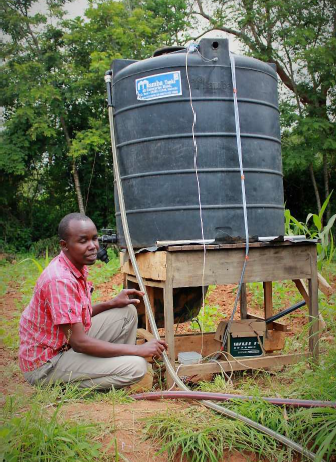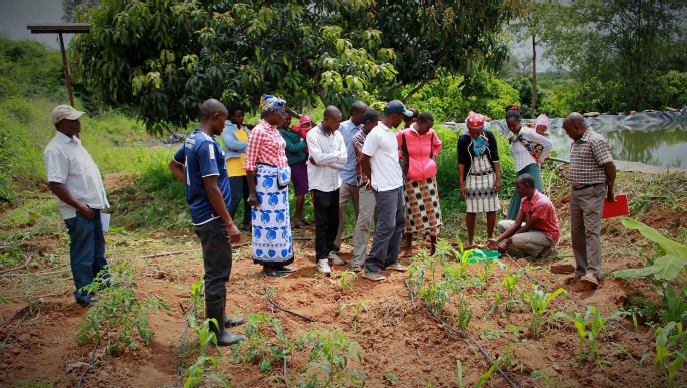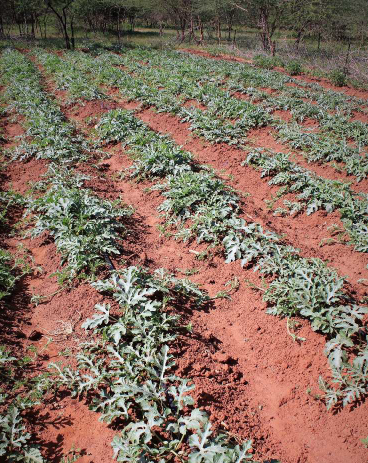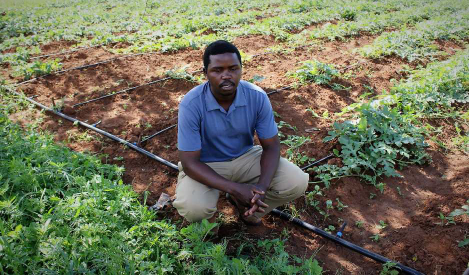DIY Solar Drip Irrigation Kit
Published on by Bernie Omodei, Owner at Measured Irrigation in Technology
World Vision Kenya, with the help of a local engineering student, installed two pilot kits last September with lead farmers to see how they would perform in the dryland context.
This article was written by Dr Rob Kelly, Grant Manager, World Vision Australia.
All photos are courtesy of World Vision Australia.
Game-changing technology for dryland farmers in eastern Kenya
Brian Hilton and I met with Bernie Omodei earlier this year; Bernie is an Aussie entrepreneur who has developed a DIY solar-powered drip-irrigation system. Farmers in the Dutch government and World Vision Australia funded Drylands Development programme (see drydev.org), Kenya, have been experimenting with drip-irrigation but the tendency is to over-water, which is a BIG issue in dryland areas.
Bernie’s gear – see www.measuredirrigation.com – is not too expensive for small-scale farmers: AUD 200 gets you the base kit. A control pack linked to an evaporation pan allocates water depending on the plants’ needs. Valves turn on or off in synch with the conditions, whether the rain is falling or the sun is blazing.
World Vision Kenya, with the help of a local engineering student, installed two pilot kits last September with lead farmers to see how they would perform in the dryland context. Mr Alphonse, a farmer near Mwala (in Machakos county), is using it to irrigate his maize and beans with a view to moving to high-value cabbage, tomatoes and watermelons if all goes to plan. While reviewing the system last Thursday, he asked me how much it cost, thinking to install another set. Even at this price, four other farmers in his producer group, called “Sweat is Sweet”, put up their hands saying they would take a loan to buy the system.
For Alphonse, it’s a game-changer: once set up, the system frees him up to concentrate on other tasks such as chicken-raising or small green-grocery, even for a week or longer.

Image: Alphonse showing how his solar-powered pump delivers water from his farm pond to a tank for subsequent gravity-fed irrigation

Image: “Sweat is Sweet” group examining Alphonse’s evaporation pan, which ensures water is applied depending on the ambient conditions
A second farmer, Mr Stephen Kithusi, is using his system to produce watermelons. His plot is quite small, just 1/8 of an acre (approx. 500 m2), but is wall-to-wall seedlings planted into neat furrows. A 2,000 L tank mounted on a roof supplies water to the drippers by gravity feed, with daily application based on water loss (or gain) in Stephen’s evaporation pan.
The potential income of a watermelon crop is impressive: Stephen hopes to produce at least three fruit per plant, each one weighing 5-7 kg. Fruit from the 1,200 seedlings in his patch, fetching the market price of 25 Ksh per kg (approx. USD 0.25 c/kg), would provide income of around 450,000 Ksh (USD 4,500) after just 8-10 weeks’ growth. After deducting running costs, labour and input expenses, the profits remain very attractive for small-scale farmers who traditionally grew the staple crops of mung beans, maize and cowpeas.
The DryDev programme is offering to link Stephen with a market wholesaler that provides seeds, fertiliser inputs, and purchases the crop at a guaranteed market price, assisting with post-harvest logistics. The contract arrangement would give Stephen confidence to invest in his farm, such as installing a farm pond or ensuring he has sufficient tanks to deliver water by gravity-feed to his crops. He also thought such a contract arrangement would solve his marketing headache: even a small volume of watermelons or tomatoes that come into the small local market would force the price down. His family is also happy; securing a job outside the farm is no longer necessary.

Image: Stephen’s watermelon crops after 4-weeks growth

Image: Stephen explaining how his drip irrigation system applies water when necessary with no wasted water
Attached link
http://www.youtube.com/embed/rVkkQvdJa4gMedia
Taxonomy
- Drip Irrigation
- Automation
- Pumps
- Evaporation
- Solar Water Pumping
- Pumped Storage
- Solar Power